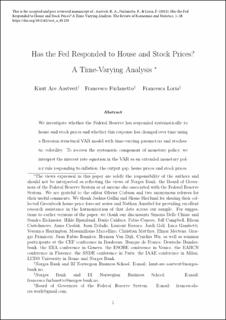| dc.description.abstract | We investigate whether the Federal Reserve has responded systematically to house and stock prices and whether this response has changed over time using a Bayesian structural VAR model with time-varying parameters and stochastic volatility. To recover the systematic component of monetary policy, we interpret the interest rate equation in the VAR as an extended monetary policy rule responding to ination, the output gap, house prices and stock prices. Our results indicate that the systematic component of monetary policy in the U.S. responded to real stock price growth significantly but episodically, mainly around recessions and periods of financial instability, and took real house price growth into account only in the years preceding the Great Recession. Around half of the estimated response captures the predictor role of asset prices for future ination and real economic activity, while the remaining component reects a direct response to stock prices and house prices. | en_US |
